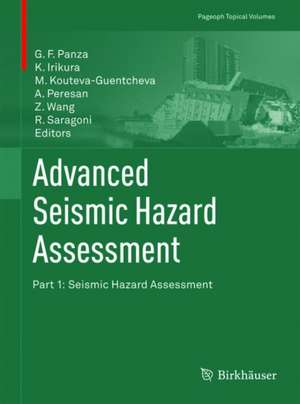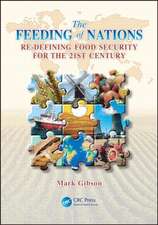Advanced Seismic Hazard Assessment: Part I: Seismic Hazard Assessment: Pageoph Topical Volumes
Editat de Giuliano F. Panza, Kojiro Irikura, Mihaela Kouteva-Guentcheva, Antonella Peresan, Zhenming Wang, Rodolfo Saragonien Limba Engleză Paperback – 27 mai 2011
This two-part volume advocates advanced methods for SHA that utilize up to date earthquake science and basic scientific principles to derive the seismic hazard in terms of a ground motion or related quantity and its occurrence frequency at a site, as well as the associated uncertainty. It aims to: (1) identify the issues in the current SHAs, (2) facilitate the development of a scientifically consistent approach for SHA and (3) disseminate, both in scientific and in engineeringpractice societies, advanced reliable tools for independent hazard estimates, like NDSHA (neo-deterministic SHA), which incorporates physically based ground motion models. It provides a fresh approach to seismic hazard analysis.
Part 1 deals with the general issues of SHA methodology review and development, as well as with recent advances in earthquake science that may have relevant implications toward an improved SHA. It is addressed to seismologists, engineers and stake-holders, and aims to contribute to bridging between modern interdisciplinary research and practitioners.
| Toate formatele și edițiile | Preț | Express |
|---|---|---|
| Paperback (2) | 613.21 lei 38-44 zile | |
| Springer – 27 mai 2011 | 613.21 lei 38-44 zile | |
| Springer – 27 mai 2011 | 629.91 lei 38-44 zile |
Din seria Pageoph Topical Volumes
-
 Preț: 370.10 lei
Preț: 370.10 lei -
 Preț: 377.84 lei
Preț: 377.84 lei - 15%
 Preț: 692.87 lei
Preț: 692.87 lei - 15%
 Preț: 698.82 lei
Preț: 698.82 lei -
 Preț: 382.30 lei
Preț: 382.30 lei -
 Preț: 371.37 lei
Preț: 371.37 lei -
 Preț: 377.12 lei
Preț: 377.12 lei -
 Preț: 338.19 lei
Preț: 338.19 lei -
 Preț: 378.58 lei
Preț: 378.58 lei -
 Preț: 369.90 lei
Preț: 369.90 lei -
 Preț: 386.16 lei
Preț: 386.16 lei -
 Preț: 371.55 lei
Preț: 371.55 lei -
 Preț: 373.24 lei
Preț: 373.24 lei -
 Preț: 389.65 lei
Preț: 389.65 lei -
 Preț: 381.34 lei
Preț: 381.34 lei -
 Preț: 388.93 lei
Preț: 388.93 lei -
 Preț: 476.69 lei
Preț: 476.69 lei - 15%
 Preț: 622.29 lei
Preț: 622.29 lei - 15%
 Preț: 631.70 lei
Preț: 631.70 lei -
 Preț: 339.47 lei
Preț: 339.47 lei -
 Preț: 375.81 lei
Preț: 375.81 lei -
 Preț: 381.34 lei
Preț: 381.34 lei -
 Preț: 405.96 lei
Preț: 405.96 lei -
 Preț: 385.99 lei
Preț: 385.99 lei -
 Preț: 344.27 lei
Preț: 344.27 lei -
 Preț: 371.73 lei
Preț: 371.73 lei -
 Preț: 378.58 lei
Preț: 378.58 lei - 18%
 Preț: 1168.06 lei
Preț: 1168.06 lei - 20%
 Preț: 615.02 lei
Preț: 615.02 lei -
 Preț: 373.98 lei
Preț: 373.98 lei -
 Preț: 365.65 lei
Preț: 365.65 lei - 15%
 Preț: 635.31 lei
Preț: 635.31 lei -
 Preț: 381.34 lei
Preț: 381.34 lei -
 Preț: 382.30 lei
Preț: 382.30 lei -
 Preț: 393.75 lei
Preț: 393.75 lei -
 Preț: 384.13 lei
Preț: 384.13 lei -
 Preț: 370.62 lei
Preț: 370.62 lei -
 Preț: 379.31 lei
Preț: 379.31 lei -
 Preț: 385.26 lei
Preț: 385.26 lei -
 Preț: 380.24 lei
Preț: 380.24 lei -
 Preț: 374.71 lei
Preț: 374.71 lei -
 Preț: 385.06 lei
Preț: 385.06 lei -
 Preț: 398.02 lei
Preț: 398.02 lei -
 Preț: 416.93 lei
Preț: 416.93 lei - 15%
 Preț: 620.23 lei
Preț: 620.23 lei -
 Preț: 373.03 lei
Preț: 373.03 lei - 15%
 Preț: 560.36 lei
Preț: 560.36 lei - 15%
 Preț: 624.77 lei
Preț: 624.77 lei
Preț: 613.21 lei
Preț vechi: 766.51 lei
-20%
Puncte Express: 920
Preț estimativ în valută:
108.55€ • 126.08$ • 94.04£
108.55€ • 126.08$ • 94.04£
Carte tipărită la comandă
Livrare economică 25 februarie-03 martie
Preluare comenzi: 021 569.72.76
Specificații
ISBN-13: 9783034800396
ISBN-10: 3034800398
Pagini: 400
Ilustrații: VI, 366 p.
Dimensiuni: 193 x 260 x 25 mm
Greutate: 0.52 kg
Ediția:2011
Editura: Springer
Colecția Birkhäuser
Seria Pageoph Topical Volumes
Locul publicării:Basel, Switzerland
ISBN-10: 3034800398
Pagini: 400
Ilustrații: VI, 366 p.
Dimensiuni: 193 x 260 x 25 mm
Greutate: 0.52 kg
Ediția:2011
Editura: Springer
Colecția Birkhäuser
Seria Pageoph Topical Volumes
Locul publicării:Basel, Switzerland
Public țintă
ResearchCuprins
Panza G.F. et al.; Introduction.- Wang Z.; Seismic Hazard Assessment: Issues and Alternatives.- Klügel J.U.; Uncertainty Analysis and Expert Judgment in Seismic Hazard Analysis.- Klügel J.U.; Scenario-based seismic risk analysis: An engineering approach for the development of source and site specific ground motion time histories in areas of low seismicity.- Zuccolo E. et al.; Neo-deterministic (NDSHA) and probabilistic (PSHA) seismic hazard assessments: a comparison over the Italian territory.- Irikura K. et al.; Recipe for Predicting Strong Ground Motion from Crustal Earthquake Scenarios.- Asano K. et al.; Characterization of Stress Drop on Asperity Estimated from Heterogeneous Kinematic Slip Model for Strong Motion Prediction of Inland Crustal Earthquake in Japan.- Iwata T. et al.; Characterization of heterogeneous source model of intraslab earthquakes toward strong ground motion prediction.- Ruiz S. et al.; Identification of High Frequency Pulses from Earthquake Asperities AlongChilean Subduction Zone using Strong Motion.- Yamada M. et al.; Statistical Analysis of Ground Motions Estimated on the Basis of a Recipe for Strong-motion Prediction ~Approach to Quantitative Evaluation of Average and Standard Deviation of Ground Motion Distribution~.- Gusev A.; Broadband kinematic stochastic simulation of an earthquake source: a refined procedure for application in seismic hazard studies.- La Mura C. et al.; Three-dimensional seismic wave propagation by modal summation: method and validation.- Martelli A.; On the Need for a Reliable Seismic Input Assessment for Optimized Design & Retrofit of Seismicaly Isolated Civil and Industrial Structures, Equipment and Cultural heritage.- Mollaioli F. et al.; Correlations between Energy and Displacement Demands for Performance based Seismic Engineering.- Sandi H. et al.; Intensity Spectra versus Response Spectra, Basic Concepts and Applications.- Varga P.; Geodetic Strain Observations and Return Period of Strongest Earthquakes of a Given Seismic Source Zone.- Nekrasova A. et al.; A Multiscale Application of the Unified Scaling Law for Earthquakes in the Central Mediterranean area and Alpine region.- Bormann P.; From earthquake prediction research to time-variable seismic hazard assessment application.
Textul de pe ultima copertă
Issues pertaining to urban risks are a pressing concern for those involved in disasters mitigation. Development of effective mitigation strategies requires sound seismic hazard information that is commonly derived through a seismic hazard assessment (SHA). The purpose of SHA is to provide a scientifically consistent estimate of seismic hazard for engineering design and other considerations. The time is ripe to move beyond the old paradigms of the traditional Probabilistic Seismic Hazard Analysis (PSHA).
This two-part volume advocates advanced methods for SHA that utilize up to date earthquake science and basic scientific principles to derive the seismic hazard in terms of a ground motion or related quantity and its occurrence frequency at a site, as well as the associated uncertainty. It aims to: 1) identify the issues in the current SHAs, 2) facilitate the development of a scientifically consistent approach for SHA and 3) disseminate, both in scientific and in engineering practice societies, advanced reliable tools for independent hazard estimates, like NDSHA (neo-deterministic SHA), which incorporates physically based ground motion models. It provides a fresh approach to seismic hazard analysis.
Part 1 deals with the general issues of SHA methodology review and development, as well as with recent advances in earthquake science that may have relevant implications toward an improved SHA. It is addressed to seismologists, engineers and stake-holders, and aims to contribute to bridging between modern interdisciplinary research and practitioners.
This two-part volume advocates advanced methods for SHA that utilize up to date earthquake science and basic scientific principles to derive the seismic hazard in terms of a ground motion or related quantity and its occurrence frequency at a site, as well as the associated uncertainty. It aims to: 1) identify the issues in the current SHAs, 2) facilitate the development of a scientifically consistent approach for SHA and 3) disseminate, both in scientific and in engineering practice societies, advanced reliable tools for independent hazard estimates, like NDSHA (neo-deterministic SHA), which incorporates physically based ground motion models. It provides a fresh approach to seismic hazard analysis.
Part 1 deals with the general issues of SHA methodology review and development, as well as with recent advances in earthquake science that may have relevant implications toward an improved SHA. It is addressed to seismologists, engineers and stake-holders, and aims to contribute to bridging between modern interdisciplinary research and practitioners.
Caracteristici
Provides a fresh, but comprehensive multi-disciplinary, physically sound approach to Advanced Seismic Hazard Assessment; Bridges the gap between modern interdisciplinary research and problems faced by practitioners in earthquake risk management; Motivates a change in perspective with respect to approaches and paradigms;










